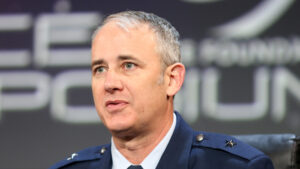
Artist’s illustration of a hypersonic missile tracking satellite constellation. (Graphic by L3Harris)
SPACE SYMPOSIUM: The $1 billion in new money to track hypersonic missiles included in the Space Force’s fiscal 2023 budget request will be split among several different efforts, to include bringing the current “digital design” study of new satellites in the little-used Medium Earth Orbit into the “real,” according to a senior official at the service’s acquisition command.
Brig. Gen. Jason Cothern, Space Systems Command (SSC) deputy, told Breaking Defense on Wednesday that about $400 million of the new funds, if appropriated, would go procurement of a new MEO constellation for keeping tabs on hypersonic missiles based on the outcome of the Missile Track Custody Prototype (TCD) program.
The rest of the funding is slated for the Space Development Agency’s (SDA) Tracking Layer of satellites, also being optimized for finding and tracking hypersonic missiles but from Low Earth Orbit (LEO), as well as a new ground system architecture to support both of them.
The end goal is to eventually integrate both the new constellations into the “hybrid” missile warning/tracking architecture put together last fall by the Space Warfighting Analysis Center (SWAC). That architecture also includes SSC’s Next-Generation Overhead Persistent Infrared (Next-Gen OPIR) ballistic missile warning constellation in Geosynchronous Orbit (GEO), and potentially commercial capabilities as well.

Space Force’s Brig. Gen. D. Jason Cothern speaks at the Space Foundation’s annual Space Symposium on April 7, 2022. (Credit: Space Foundation)
To coordinate it all the Pentagon is standing up a “combined program office” involving SSC, SDA and the Missile Defense Agency (MDA) to manage implementation of the new architecture, Cothern told reporters at the Space Foundation’s annual Space Symposium on Wednesday.
“It was approved in February by the service acquisition executive — I believe that’s what the date was — and we’re writing a memorandum of agreement to codify and solidify that that arrangement,” elaborated Col. Brian Denaro, SSC’s program executive officer of space sensing.
The TCD prototyping project also is a flagship in SSC’s effort to move toward digital design and digital engineering to help speed its procurement efforts. TCD currently is focused on development of a digital design for potential future satellites instead of a traditional prototyping effort. SSC signed 18-month contracts with two vendors: with Raytheon receiving $29 million in April, and Millennium Space receiving $28.1 million in May.
“We have used the track custody demo, which was awarded last year, to be a pathfinder for this effort,” Denaro said. “That program was born digital. And so the two vendors that are involved in that have been building digital models that we have been incorporating through design reviews with them, and testing out those capabilities against the new architecture, and the performance that we expect to see.”
He added that the digital designs due to SSC in November will go through critical design review next year. “And we’ll make a decision, based on the progress that we see, on the future architecture of what we actually field into orbit.”
If a decision is made to go onto a second phase of the effort, the current study contracts have options for Space Force to buy up to three satellites from each to test on orbit, while possibly provide early capability for warfighters.






















